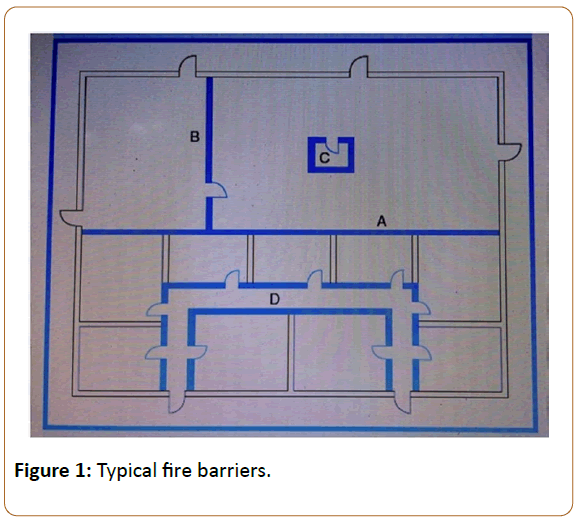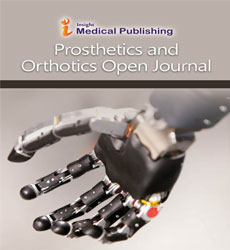Fire Hazards Associated with Prosthodontics and their Management
Pankaj Kharade*
Department of Prosthodontics, Dr.Z.A Dental College and Hospital, Aligarh Muslim University, Aligarh, India
- Corresponding Author:
- Kharade P
Department of Prosthodontics
Dr.Z.A Dental College and Hospital
Aligarh Muslim University, Aligarh, India
Tel: 918976725407
E-mail: drpankaj.pgi08@gmail.com
Received Date: March 21, 2017; Accepted Date: May 15, 2017; Published Date: May 19, 2017
Citation: Kharade P (2017) Fire Hazards Associated with Prosthodontics and their Management. Pros Orth Open J 1:9.
Copyright: © 2017 Kharade P. This is an open-access article distributed under the terms of the Creative Commons Attribution License, which permits unrestricted use, distribution, and reproduction in any medium, provided the original author and source are credited.
Letter to the Editor
Physical hazards frequently bump into the prosthodontic procedures. Amongst the various physical hazards taking place during prosthodontic procedures burn injury is most universal in the institutional set up. Fire related hazards manifest recurrently during prosthodontic clinical and laboratory procedures. According to World Health Institution the term "hazard" refers to an inherent property of an agent, or situation having the potential to origin unfavorable effects when an organism, system, or population is exposed to that agent [1,2]. Fire hazards in prosthodontic complex are typically associated with the use of bunsen burners, spirit lamps, furnaces and blow torches. These devices may engender life threatening state of affairs not only for clinicians and laboratory technicians but also to students in institutional setups. Apart from that fire in the workplace may lead to a major psychological disturbance for the employer as well as employees [3].
For creating safe and sound working environment in the prosthodontic clinic and laboratory methodical training with reference to their use and apposite management of fire hazards is very crucial. Staff and students are first required to recognize an emergency action plan provided as per OSHA guidelines and comprehend a fire prevention strategy as well. Principal objective of Occupational Safety and Health Administration (OSHA) is to reinforce attentiveness among the workers regarding work hazard and their management [4]. NFPA 101-Life Safety Code is the most widely used source for stratagems to shield people based on building construction, protection, and occupancy features that minimize the effects of fire and related hazards. The title of the NFPA 101- Life Safety Code was changed from Building Exits Code to Code for Safety to Life from Fire in Buildings and Structures in 1966 [5]. The change in title enhanced the scope of the Code from a specification-based code for stairs, doors, and fire escapes to a performance- and specification-based code that tackles the myriad factors that influence life security in the incident of fire. It is the single document that covers up life safety in new and existing structures mutually in an exceptional manner in the field. 2010 Oregon Fire Code (OFC) also gives guidelines in the same manner as NFPA 101-Life Safety Code does. 2010 Oregon Fire Code guidelines are concerning Fire Safety and Evacuation Plan to be structured and continued for healthcare occupancies [6]. Oregon Fire Code looks forward for the training of the employees and students with respect to their duties under this plan. In addition, a plan must be ready with all the details regarding how a facility will manage the situations in which the building fire sprinkler system and/or fire alarm system are out of order. These codes also enclose requirements concerning to the flame confrontation of drapes, curtains, flame spread score of infrastructures and, by reference to other NFPA standards the testing, examination and preservation of fire protection systems. In order to obtain credit during a fire/life safety survey, it’s not adequate just to have the obligatory preparation [7]. The plan must enclose at least all the particular information in the codes. Everything must be appropriately documented and accessible. If it is not documented then it is considered that it didn’t happen. In order to meet state licensure requirements, healthcare facilities must be fulfilled as per the 2010 Oregon Fire Code (OFC).
Fire hazards management fundamentally consists of subsequent elements
Identifying fire hazards: To recognize the fire hazard may be the preliminary step to augment the awareness about fire hazards among the students and professionals. Various elements such as spirit lamp, Bunsen burner, blow torch and furnaces are inescapable part of prosthodontic setup. The most widespread injuries in an institutional set up are burns from bunsen burners and spirit lamp [8]. Storage of inflammable and combustible materials should be carried out with immense security measure in well isolated chambers. Quantity of inflammable and combustible liquids located outside of storage cabinets should be constrained to barely single day supply, or to which can be used during a single budge. The management of such materials should be done by authorized persons only. Large quantity of these items should be stored as per applicable regulations and protective methods. Large storage space areas should have a fire fortification system established.
Prevention approach: Prevention of fire hazards may be considered as the paramount policy as a component of management measures [9]. Prevention strategy can be initiated from the floor plan drawing only which will direct during construction of the building and assist in future fire hazard management. Building information should be maintained effectively which includes updated 8½” × 11” floor diagram of every floor of the building, dates of completion of construction work of the entire building and any consequent modifications. The design and construction for new premises should comprise measures to reduce the hazard of internal spread of fire as well as spread to adjacent buildings [10]. The requirements for assembly occupancies are based on protecting concentrations of occupants in a building or area. NFPA 220, Standard on Types of Building Construction can be used to establish the requirements for the construction classification. In certain occupancies, minimum construction requirements are established to help preserve structural integrity for the time needed for evacuation. In the case of health care occupancies, significant time is needed to make certain the safety of non-ambulatory occupants; a safe fire and smoke compartment needs to be established within the building but away from the compartment or zone of fire origin. To preserve the integrity of a fire or smoke compartment, all openings and penetrations for doors, ducts, and building services (e.g., electric power, telephone, water supply, and waste lines) must also be efficiently closed or fitted with automatic closures. Installation of fire resistant barriers will lend a hand to shun any future catastrophe due to the fire hazards. These barriers are often used to enfold means of way out elements, such as exit stairs, corridors, and outlet passageways. All building materials used in reformation and building projects must convene the state fire code necessities for fire-resistance (Figure 1).
Escape facilities should include doors, walkways, Fire and Life Safety Practices in Hospitals stairs, ramps, fire escapes, ladders, or other standard resources or strategy arranged in accordance with the universal philosophy of fire and life safety regulations as they can realistically be applied to ongoing construction work. Inflammable materials should be stored in special cabinets which will avert an outside fire from reaching the contents for a particular period. Storage of such flammable substances should be done in a well-ventilated area so that any fumes given off from a spill or leak will be dispersed hastily. Sources of ignition such as electrical equipment, cutting tools, hot surfaces, open flames from heating equipment and smoking should be avoided in vicinity of flammable substance storage. Sunlight is a heat source and a glass window might intensify heat during the summer to a significantly soaring temperature, which has been known to cause explosion. Institution should install shielding valve caps when gas cylinder is not in exercise if the cylinder is equipped with a means of attaching caps. It is consistent that in organizations reliable ways for the quick discharge of inhabitants such as remote control of locks should be made available. The institute should have an on paper diagram for Fire Prevention as well as protection and a Fire Safety Manual approved by the security committee.
The fire protection guide should include of the subsequent components:
• Preparation for fire prevention and management.
• Maintenance agenda for scheme linked to fire prevention and control.
• Examination procedure for fire safety installations.
• Codes for declaration of fire related emergency events and communication protocols.
• Responsibilities of various sections in the event of fire.
• Procedures, incidence and protocols for mock drills.
• Establishment of Fire combating and Evacuation teams.
• Evacuation scheme.
• Electrical security and system.
• Regular inspection and maintenance of that area should be advisable.
At least one fire extinguisher should be installed in the storage area. Staff should be trained about operation technique and various steps for operation of the fire extinguisher as diverse types of fire extinguishers are available and their use depends upon the type of fire. Class A fires are fires related to usual combustibles such as wood, paper, cloth, trash, and plastics. Class B fires are related to flammable liquids such as gasoline, petroleum oil, paint and flammable gases e.g. butane. Class C fires are fires associated with electrical equipment such as motors, transformers, and appliances. Class D fires are associated with metals such as potassium, aluminum and magnesium. Class K fires are associated with cooking oils and greases such as animal fats and vegetable fats. Dry Chemical fire extinguishers manage the fire principally by interrupting the chemical reaction in the fire and are most extensively used type of fire extinguisher due to versatile use due to effect on class A, B, and C fires. Carbon Dioxide fire extinguishers control the fire by isolating the oxygen element from the fuel and heat, and also by eliminating the heat with an extremely cold discharge. Carbon dioxide type can be used on class B and C fires. Wet chemical or class K extinguishers were developed for contemporary high effectiveness deep fat fryers in viable cooking operations. Halocarbon and halon 1211 extinguishers are effective on class A, B and C type fires. Dry Powder extinguishers are comparable to dry chemical excluding that they control the fire by separating the fuel from the oxygen component of the fire and efficiency limited to class D fires only. Some of the institutions where there is no provision of fire extinguishers; staff should be instructed and trained appropriately to evacuate the premises on the juncture of fire hazards. When the fire alarm system cannot be operated, individuals authorized fire watch duties should perform a total walk-through of all influenced areas at a frequency of every 15 minutes. Fire alarms as well as voice communication systems are necessary in these circumstances. Mock fire drills must be carried out recurrently as per NFPA guidelines and their record should be maintained.
Smoking materials (i.e., cigarettes, cigars, pipes, etc.) are the most important origin of fire hazards. Prime fact is staff should inculcate the habit to avoid smoking in the institutional premises. They should not smoke in the vicinity where oxygen is being used or inflammable materials have been stored. Fire safe cigarettes are less liable to cause fires. Before throwing out butts and ashes, it should be made positive that they are out, and drenching in water or sand is the finest way to accomplish that. The Oregon legislature has approved a smoke free workplace law in June 2007 which prohibits smoking within 10 feet distance of entrances, exits as well as windows.
National Accreditation Board for Hospitals and Healthcare Providers (NABH) safety regulations: NABH is an element board of quality commission of India, set up to launch and function accreditation programme for healthcare institutions. NABH safety strategy for fire hazards prevention directs to guarantee that the institution is amenable with fire. These safety regulations comprise a few of the following vital guidelines [11].
The institution should have No Objection Certificate issued from state Fire Department [12,13]. The institution should formally appoint a Fire Safety Officer in-charge to deal with Fire Prevention and Safety [14]. The institution should have an Emergency Command Centre that becomes efficient right away whenever there is an emergency [15]. The institution should uphold procedures, frequency, protocols for mock drills and evacuation plan [16]. Regular inspection should be executed concerning electrical security and system [17]. The fire exits should be well defined and finish on the ground floor or refuge area or any safe place preferred by the management [18]. The fire doors should have an appropriate fire rating and open outside constantly. The fire alarm systems should be appropriately tested and maintained. Lift’s use should be avoided in case of fire. All the equipments must have a planned preventive schedule that is recorded. The institution should employ appropriate type and number of fire extinguishers as per the type of fire that could take place. The institution should carry out a guidance program for management of fire emergencies and their evidence should be maintained. There should be an endorsement from the Indian Explosives Department for mass storage of inflammable substance as per Indian Explosives Act, in case stored in bulk. The complete staff should be alert of the firefighting systems, responsibilities during fire emergencies, evacuation routes and techniques, familiar with the type of fire extinguishers and their area of use, trained to function fire extinguishers, code announcements and congregation points in case of fire. The institution should have guidelines for storing, dispensing and employment of inflammable materials. Suitable warning signs for inflammables should be displayed. All electrical panels should be associated with a rubber mat in front of them.
Summary
The basic objective of OSHA is to edify the professionals about the work place hazards, risk assessment, and risk management policies. Fire hazards are one of the most severe occupational risks related to prosthodontic procedures. It remains a momentous apprehension in clinic and laboratory set up. Information in relation to such hazard and acquaintance about its characteristics may amplify the awareness about prevention of these hazards but such kind of alertness should be enforced with systematic understanding of the amount of exposure to the hazard and policies to control the consequences of occupational hazards and risks to appraise the possible threat in an adequate manner. It will ease in making the staff responsive of the firefighting systems, tasks during fire emergencies, evacuation routes and techniques, acquainted with the category of fire extinguishers as well as their area of use. Staff will get trained to maneuver fire extinguishers, code announcements and gathering points in circumstances of fire. A safe and healthy working environment for clinicians, laboratory technicians as well as students in the institutional setups can be achieved by recognizing the hazards and by following hazard management practice. Regular inspection and maintenance is advisable. Appropriate planning and accurate execution Fire Hazards Management strategies are indispensable means to craft occupation environment which is secured from fire.
References
- IOMC, WHO Risk assessment terminology: Part 1. International Program on Chemical Safety.
- IOMC, WHO Risk assessment terminology: Part 2. International Program on Chemical Safety.
- McKimmie BM, Jimmieson NL, Mathews R, Moffat K (2009) Social support and fires in the workplace: a preliminary investigation. Work 32: 59-68.
- Occupational Safety and Health Administration.
- Cote R, Gregory H Life Safety Code Handbook. (11thedn.).
- McDonald RI, Walsh LJ, Savage NW (1997) Analysis of workplace injuries in a dental school environment. Aust Dent J 42: 109–113.
- Colonna G (2001) Introduction to Employee Fire and Life Safety. National Fire Protection Association.
- Cote AE (1997) Fire Prevention Handbook. ( 18thedn.), MA: NFPA, Quincy.
- NFPA 25 standard for the inspection, testing, and maintenance of water-based fire protection systems. (2011edn.), National Fire Protection Association.
- htttp://www.environ.ie
- Fire safety regulations. NABH
- https://www.osha.europa.eu/en
- https://www.irishfireservices.ie
- Griffiths R (2009) Managing fire safety in care homes. Nursing and Residential Care 11: 249-255.
- Cann O (2009) Worth the risk. Fire Risk Management 9: 15-18.
- Lewis A, Dailey W (2006) Fire risk management in the workplace. A guide for employers. (3rdedn.), Fire Protection Publication
- Great Britain Home Office (2001) Fire Safety – An Employer’s Guide. (1stedn.), Stationary Office Books
- Health and Safety Executive (2008) Take care with oxygen: Fire and explosion hazards in the use of oxygen.

Open Access Journals
- Aquaculture & Veterinary Science
- Chemistry & Chemical Sciences
- Clinical Sciences
- Engineering
- General Science
- Genetics & Molecular Biology
- Health Care & Nursing
- Immunology & Microbiology
- Materials Science
- Mathematics & Physics
- Medical Sciences
- Neurology & Psychiatry
- Oncology & Cancer Science
- Pharmaceutical Sciences

